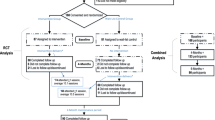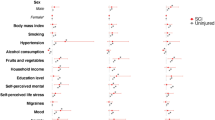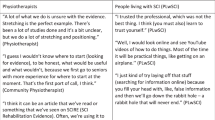Abstract
Objectives:
To systematically develop evidence-informed physical activity guidelines to improve physical fitness in people with spinal cord injury (SCI).
Setting:
This study was conducted in Canada
Methods:
The Appraisal of Guidelines, Research and Evaluation II guideline development protocol was used to develop exercise guidelines to improve physical capacity and muscular strength. The evidence base for the guideline development process consisted of a systematic review and quality appraisal of research examining the effects of exercise on physical fitness among people with SCI. A multidisciplinary expert panel deliberated the evidence and generated the guidelines. Pilot testing led to refinement of the wording and presentation of the guidelines.
Results:
The expert panel generated the following guidelines: for important fitness benefits, adults with a SCI should engage in (a) at least 20 min of moderate to vigorous intensity aerobic activity two times per week and (b) strength training exercises two times per week, consisting of three sets of 8–10 repetitions of each exercise for each major muscle group.
Conclusion:
People with SCI, clinicians, researchers and fitness programmers are encouraged to adopt these rigorously developed guidelines.
Similar content being viewed by others
Log in or create a free account to read this content
Gain free access to this article, as well as selected content from this journal and more on nature.com
or
References
Garshick E, Kelley A, Cohen SA, Garrison A, Tun CG, Gagnon D et al. A prospective assessment of mortality in chronic spinal cord injury. Spinal Cord 2005; 43: 408–416.
Noreau L, Shephard RJ . Spinal cord injury, exercise and quality of life. Sports Med 1995; 20: 226–250.
Hicks AL, Martin KA, Ditor DS, Latimer AE, Craven C, Bugaresti J et al. Long-term exercise training in persons with spinal cord injury: effects on strength, arm ergometry performance and psychological well-being. Spinal Cord 2003; 41: 34–43.
Hicks AL, Martin Ginis KA . Treadmill training after SCI: it's not just about the walking. J Rehabil Res Dev 2008; 45: 241–248.
Public Health Agency of Canada 1998 Canada's physical activity guide to healthy active living (online). Available from http://www.phac-aspc.gc.ca/hp-ps/hl-mvs/pag-gap/index-home-accueil-eng.php (accessed 09 September 2010).
American College of Sports Medicine 2008 Guidelines for healthy adults under age 65 (online). Available from http://www.acsm.org/AM/Template.cfm?Section=Home_Page&TEMPLATE=/CM/HTMLDisplay.cfm&CONTENTID=7764 (accessed 23 March 2011).
World Health Organization 2010. Global Recommendations on Physical Activity for Health. WHO Press: Geneva, Switzerland.
Martin Ginis KA, Hicks AL . Factors to be considered in creating a physical activity guide for Canadians with physical disabilities. Appl Physiol Nutr Metab 2007; 32 (Suppl 2F): S150–S164.
Tremblay MS, Kho ME, Tricco AC, Duggan M . Process description and evaluation of Canadian Physical Activity Guidelines development. Int J Behav Nutr Phys Act 2010; 7: 42.
Myers J, Nieman D (eds). ACSM's Resources for Clinical Exercise Physiology, 2nd edn. Wolters Luwer/Lippincott Williams & Wilkins: Baltimore, 2010.
Jacobs PL, Nash MS . Exercise recommendations for individuals with spinal cord injury. Sports Med 2004; 34: 727–751.
Myslinski MJ . Evidence-based exercise prescription for individuals with spinal cord injury. J Neurol Phys Ther 2005; 29: 104–106.
Brouwers MC, Kho ME, Browman G, Burgers J, Cluzeau F, Feder G et al. AGREE II: advancing guideline development, reporting and evaluation in healthcare. CMAJ 2010; 182: E839–E842.
Brouwers MC, Kho ME, Browman G, Burgers J, Cluzeau F, Feder G et al. AGREE II: advancing guideline development, reporting and evaluation in healthcare. J Clin Epidemiol 2010; 63: 1308–1311.
Brouwers MC, Kho ME, Browman G, Burgers J, Cluzeau F, Feder G et al. AGREE II: advancing guideline development, reporting and evaluation in healthcare. Prev Med 2010; 51: 421–424.
Hicks AL, Martin Ginis KA, Pelletier C A, Ditor DS, Foulon B, Wolfe DL . The effects of exercise training on physical capacity, strength, body composition and functional performance among adults with spinal cord injury: a systematic review. Spinal Cord 2011; 49: 1103–1127.
Heesterbeek PJC, Berkelmans HWA, Thijssen DHJ, van Kuppevelt HJM, Hopman MTE, Duysens J . Increased physical fitness after 4-week training on a new hybrid FES-cycle in persons with spinal cord injury. Technol Disabil 2005; 17: 103–110.
Jacobs PL . Effects of resistance and endurance training in persons with paraplegia. Med Sci Sports Exerc 2009; 41: 992–997.
Janssen TW, Pringle DD . Effects of modified electrical stimulation-induced leg cycle ergometer training for individuals with spinal cord injury. J Rehabil Res Dev 2008; 45: 819–830.
Hooker SP, Wells CL . Effects of low- and moderate-intensity training in spinal cord-injured persons. Med Sci Sports Exerc 1989; 21: 18–22.
Nilsson S, Staff PH, Pruett DR . Physical work capacity and the effect of training on subjects with long-standing paraplegia. Scand J Rehab Med 1975; 7: 51–56.
Whiting RB, Dreisinger TE, Dalton RB, Londeree BR . Improved physical fitness and work capacity in quadriplegics by wheelchair exercise. J Cardiac Rehab 1983; 3: 251–255.
de Carvalho DC, Martins CL, Cardoso SD, Cliquet Jr A . Improvement of metabolic and cardiorespiratory responses through treadmill gait training with neuromuscular electrical stimulation in quadriplegic subjects. Artif Organs 2006; 30: 56–63.
Ornstein LJ, Skrinar GS, Carrett GG . Physiological effects of swimming training in physicaly disabled individuals. Med Sci Sports Exerc 1983; 15: 110.
Tordi N, Dugue B, Klupzinski D, Rasseneur L, Rouillon JD, Lonsdorfer J . Interval training program on a wheelchair ergometer for paraplegic subjects. Spinal Cord 2001; 39: 532–537.
Buchholz AC, Martin Ginis KA, Bray SR, Craven BC, Hicks AL, Latimer AE et al. Greater daily leisure time physical activity is associated with lower chronic disease risk in adults with spinal cord injury. Appl Physiol Nutr Metab 2009; 34: 640–647.
The Spinal Cord Injury Rehabilitation Evidence (SCIRE) 2010 (online) Available from http://www.scireproject.com/ (accessed 09 September 2010).
Centers for Disease Control and Prevention 2010. Physical activity for everyone: how much physical activity do adults need?. (online). Available at http://www.cdc.gov/physicalactivity/everyone/guidelines/adults.html (accessed 9 September 2010).
Krassioukov A, Eng JJ, Warburton DE, Teasell R, Spinal cord injury rehabilitation evidence research team. A systematic review of the management of orthostatic hypotension after spinal cord injury. Arch Phys Med Rehabil 2009; 90: 876–885.
Krassioukov A, Warburton DE, Teasell R, Eng JJ, Spinal Cord Injury Rehabilitation Evidence Research Team. A systematic review of the management of autonomic dysreflexia after spinal cord injury. Arch Phys Med Rehabil 2009; 90: 682–695.
Canada Fitness and Lifestyle Research Institute (CFLRI). Physical activity levels across Canada. (online). Available at http://www.cflri.ca/eng/levels/index.php (accessed 16 September 2010).
Martin Ginis KA, Latimer AE, Hicks AL, Craven BC . Development and evaluation of an activity measure for people with spinal cord injury. Med Sci Sports Exerc 2005; 37: 1099–1111.
Brouwers M, Stacey D, O’Connor A . Knowledge creation: synthesis, tools and products. CMAJ 2010; 182: E68–E72.
Acknowledgements
We gratefully acknowledge Dr Luc Noreau who provided the initial impetus for this project. Development of the guidelines and preparation of the manuscript were financially supported by the Rick Hansen Institute; a Community-University Research Alliance Grant from the Social Sciences and Humanities Research Council of Canada; a Canadian Institutes of Health Research New Investigator Award (awarded to KMG); an Ontario Neurotrauma Foundation Mentor-Trainee Award (awarded to KMG and AL). We extend our appreciation to Adrienne Sinden for her assistance with preparing the manuscript.
Author information
Authors and Affiliations
Corresponding author
Ethics declarations
Competing interests
The authors declare no conflict of interest.
Rights and permissions
About this article
Cite this article
Ginis, K., Hicks, A., Latimer, A. et al. The development of evidence-informed physical activity guidelines for adults with spinal cord injury. Spinal Cord 49, 1088–1096 (2011). https://doi.org/10.1038/sc.2011.63
Received:
Revised:
Accepted:
Published:
Issue date:
DOI: https://doi.org/10.1038/sc.2011.63
Keywords
This article is cited by
-
Rowing exercise increases cardiorespiratory fitness and brachial artery diameter but not traditional cardiometabolic risk factors in spinal cord-injured humans
European Journal of Applied Physiology (2023)
-
Usability of an exosuit in domestic and community environments
Journal of NeuroEngineering and Rehabilitation (2022)
-
A multimodality intervention to improve musculoskeletal health, function, metabolism, and well-being in spinal cord injury: study protocol for the FIT-SCI randomized controlled trial
BMC Musculoskeletal Disorders (2022)
-
Telerehabilitation for individuals with spinal cord injury in low-and middle-income countries: a systematic review of the literature
Spinal Cord (2022)
-
Qualitative analysis of perceived motivators and barriers to exercise in individuals with spinal cord injury enrolled in an exercise study
Spinal Cord Series and Cases (2022)



